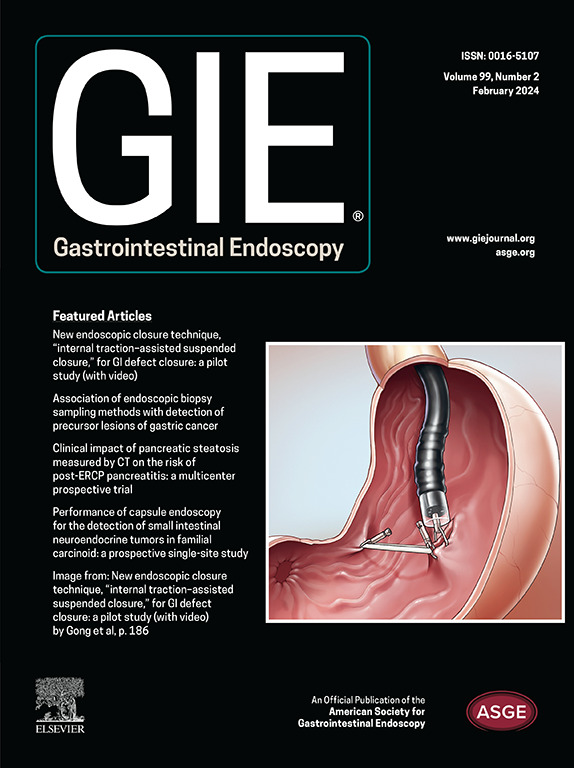Deciphering the clinical spectrum of gastric disease in patients with juvenile polyposis syndrome
IF 6.7
1区 医学
Q1 GASTROENTEROLOGY & HEPATOLOGY
引用次数: 0
Abstract
Background and Aims
Juvenile polyposis syndrome (JPS) is a rare hereditary autosomal dominant cancer-predisposition syndrome caused by germline pathogenic variants (PVs) located in SMAD4 or BMPR1A genes. Accurate clinical and endoscopic data regarding the evolution of gastric lesions remain sparse.
Methods
Clinical, endoscopic, genetic, and pathologic data from patients with SMAD4 or BMPR1A PVs included between 2007 and 2020 in the French network on rare digestive polyposis (RENAPOL [French National Polyposis Register]) database were prospectively collected to address uncertainties regarding gastric involvement.
Results
Thirty-six patients were included: 25 (69.5%) had SMAD4 PVs, and 11 had BMPR1A PVs. For SMAD4 PV carriers, median age at inclusion was 43.0 years (range, 10-78 years). At baseline EGD, 22 (88%) of 25 patients exhibited at least 1 gastric juvenile polyp, and 5 (20%) of 25 had macroscopic signs of inflammatory gastritis. Early gastric disease was mostly located under the cardia, then progressed to the gastric antrum and body. During a mean follow-up period of 55.0 months, 12 of 25 patients had gastric disease progression (ie, new juvenile polyps [91.6%], diffuse gastric involvement [41.6%], inflammatory flat progression [25%]). Among 62 biopsies, low-grade dysplasia was observed in 5 (7.5%) samples from 2 patients. Nine carriers (36%) underwent gastrectomy (mean age, 47.2 years) due to diffuse gastric involvement or worsening clinical symptoms. Gastric adenocarcinoma (T1) was found in 1 gastrectomy specimen. Among the 11 patients with BMPR1A PVs, 2 had gastric hamartomatomas at baseline EGD, none with dysplasia or symptoms.
Conclusions
Gastric involvement in JPS seems to be progressive over a lifetime, initiates in the cardia area, and mostly involves SMAD4 PV carriers.
解读幼年息肉病综合征患者胃病的临床表现。
背景和目的:幼年性息肉病综合征(JPS)是一种罕见的遗传性常染色体显性癌症易感综合征,由位于SMAD4或BMPR1A基因的种系致病变体(PV)引起。精确的临床和内镜表现以及胃部病变的演变过程仍不为人所知:方法:前瞻性地收集了法国罕见消化道息肉病网络(RENAPOL)数据库在 2007 年至 2020 年间收录的 SMAD4 或 BMPR1A PV 患者的临床、内镜、遗传和病理数据,以解决胃部受累方面的不确定性:结果:共纳入 36 例患者:25例(69.5%)为SMAD4 PV,11例为BMPR1A PV。SMAD4 PV携带者的中位年龄为43.0岁[10-78岁]。在基线食管胃十二指肠镜(EGD)检查中,22/25(88%)人至少有一个胃幼年息肉,5/25(20%)人有炎症性胃炎的宏观症状。早期胃病大多位于贲门下,然后发展到胃窦和胃体。在平均 55.0 个月的随访期间,有 12/25 例患者的胃病出现进展(即新的幼年息肉(91.6%)、弥漫性胃受累(41.6%)、炎性扁平进展(25%))。在 62 份活检样本中,2 名患者的 5 份样本(7.5%)出现低度发育不良。9名携带者(36%)因胃部弥漫性受累或临床症状恶化而接受了胃切除术(平均年龄47.2岁)。在一份胃切除术标本中发现了胃腺癌(T1)。在11例患有BMPR1A PV的患者中,2例在基线胃肠道造影时发现胃火腿肠瘤,但无一伴有发育不良或症状:结论:JPS患者的胃部受累似乎是终身进行性的,从贲门部位开始,主要涉及SMAD4 PV携带者。
本文章由计算机程序翻译,如有差异,请以英文原文为准。
求助全文
约1分钟内获得全文
求助全文
来源期刊

Gastrointestinal endoscopy
医学-胃肠肝病学
CiteScore
10.30
自引率
7.80%
发文量
1441
审稿时长
38 days
期刊介绍:
Gastrointestinal Endoscopy is a journal publishing original, peer-reviewed articles on endoscopic procedures for studying, diagnosing, and treating digestive diseases. It covers outcomes research, prospective studies, and controlled trials of new endoscopic instruments and treatment methods. The online features include full-text articles, video and audio clips, and MEDLINE links. The journal serves as an international forum for the latest developments in the specialty, offering challenging reports from authorities worldwide. It also publishes abstracts of significant articles from other clinical publications, accompanied by expert commentaries.
 求助内容:
求助内容: 应助结果提醒方式:
应助结果提醒方式:


